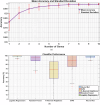Detecting suicide risk in bipolar disorder patients from lymphoblastoid cell lines genetic signatures
- PMID: 40903457
- PMCID: PMC12408843
- DOI: 10.1038/s41398-025-03573-3
Detecting suicide risk in bipolar disorder patients from lymphoblastoid cell lines genetic signatures
Abstract
This research aimed to develop a machine learning algorithm to predict suicide risk in bipolar disorder (BD) patients using RNA sequencing analysis of lymphoblastoid cell lines (LCLs). By identifying differentially expressed genes (DEGs) between high and low risk patients and their enrichment in relevant pathways, we gained insights into the molecular mechanisms underlying suicide risk. LCL gene expression analysis revealed pathway enrichment related to primary immunodeficiency, ion channels, and cardiovascular defects. Notably, genes such as LCK, KCNN2, and GRIA1 emerged as pivotal, suggesting their potential roles as biomarkers. Machine learning algorithms trained on a subset of the patients and tested on others demonstrated high accuracy in distinguishing low and high risk of suicide in BD patients. Additionally, the study explored the genetic overlap between suicide-related genes and several psychiatric disorders. Our study enhances the understanding of the complex interplay between genetics and suicidal behaviour, providing a foundation for prevention strategies.
© 2025. The Author(s).
Conflict of interest statement
Competing interests: The authors declare no competing interests Ethics approval and consent to participate: All methods were performed in accordance with the relevant guidelines and regulations. All participants provided informed consent before participating in the study. Approval for the study was obtained from the Research Ethics Board of the University of Cagliari, Italy.
Figures






Similar articles
-
Precision medicine for mood disorders: objective assessment, risk prediction, pharmacogenomics, and repurposed drugs.Mol Psychiatry. 2021 Jul;26(7):2776-2804. doi: 10.1038/s41380-021-01061-w. Epub 2021 Apr 8. Mol Psychiatry. 2021. PMID: 33828235 Free PMC article.
-
Deciphering Shared Gene Signatures and Immune Infiltration Characteristics Between Gestational Diabetes Mellitus and Preeclampsia by Integrated Bioinformatics Analysis and Machine Learning.Reprod Sci. 2025 Jun;32(6):1886-1904. doi: 10.1007/s43032-025-01847-1. Epub 2025 May 15. Reprod Sci. 2025. PMID: 40374866
-
SNP-associated differential methylation in ARHGEF38: insights into genetic-epigenetic interactions.Epigenomics. 2025 Jun;17(9):579-588. doi: 10.1080/17501911.2025.2513215. Epub 2025 May 30. Epigenomics. 2025. PMID: 40444651
-
Prevention of self-harm and suicide in young people up to the age of 25 in education settings.Cochrane Database Syst Rev. 2024 Dec 20;12(12):CD013844. doi: 10.1002/14651858.CD013844.pub2. Cochrane Database Syst Rev. 2024. PMID: 39704320
-
Predictive Performance of Machine Learning for Suicide in Adolescents: Systematic Review and Meta-Analysis.J Med Internet Res. 2025 Jun 16;27:e73052. doi: 10.2196/73052. J Med Internet Res. 2025. PMID: 40522723 Free PMC article. Review.
References
-
- World Health Organization. Suicide. (n.d.). https://www.who.int/news-room/fact-sheets/detail/suicide. Accessed 25 Mar 2025
-
- Cavanagh JT, Carson AJ, Sharpe M, Lawrie SM. Psychological autopsy studies of suicide: a systematic review. Psychol Med. 2003;33:395–405. - PubMed
MeSH terms
Substances
Grants and funding
LinkOut - more resources
Full Text Sources
Medical
Miscellaneous

